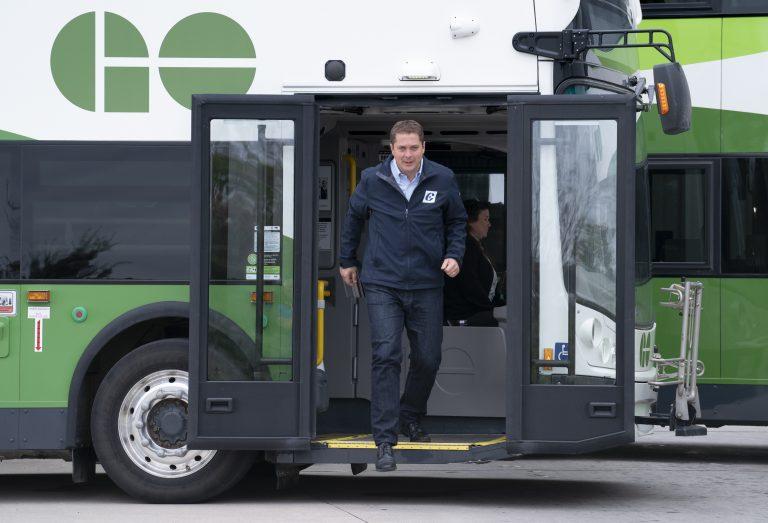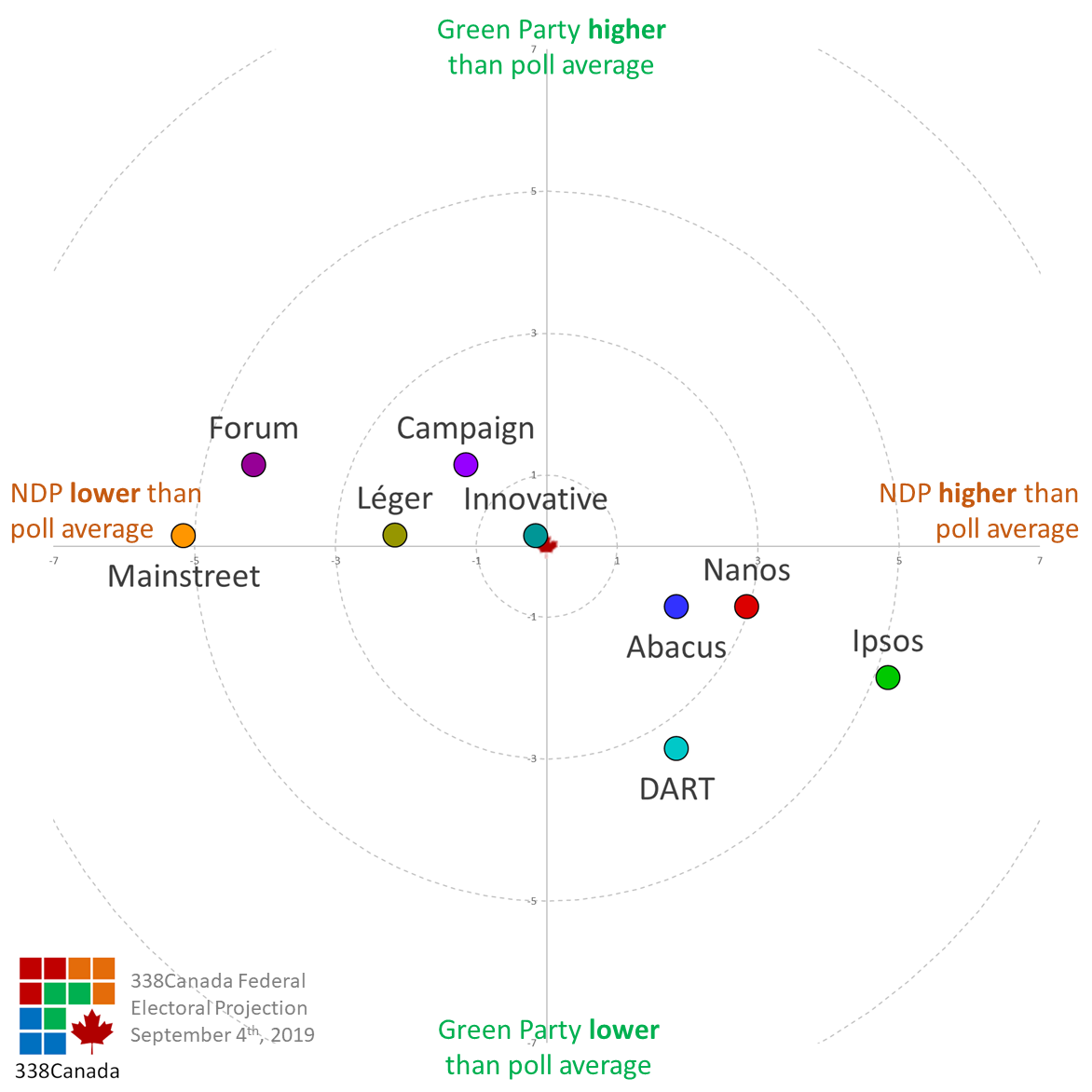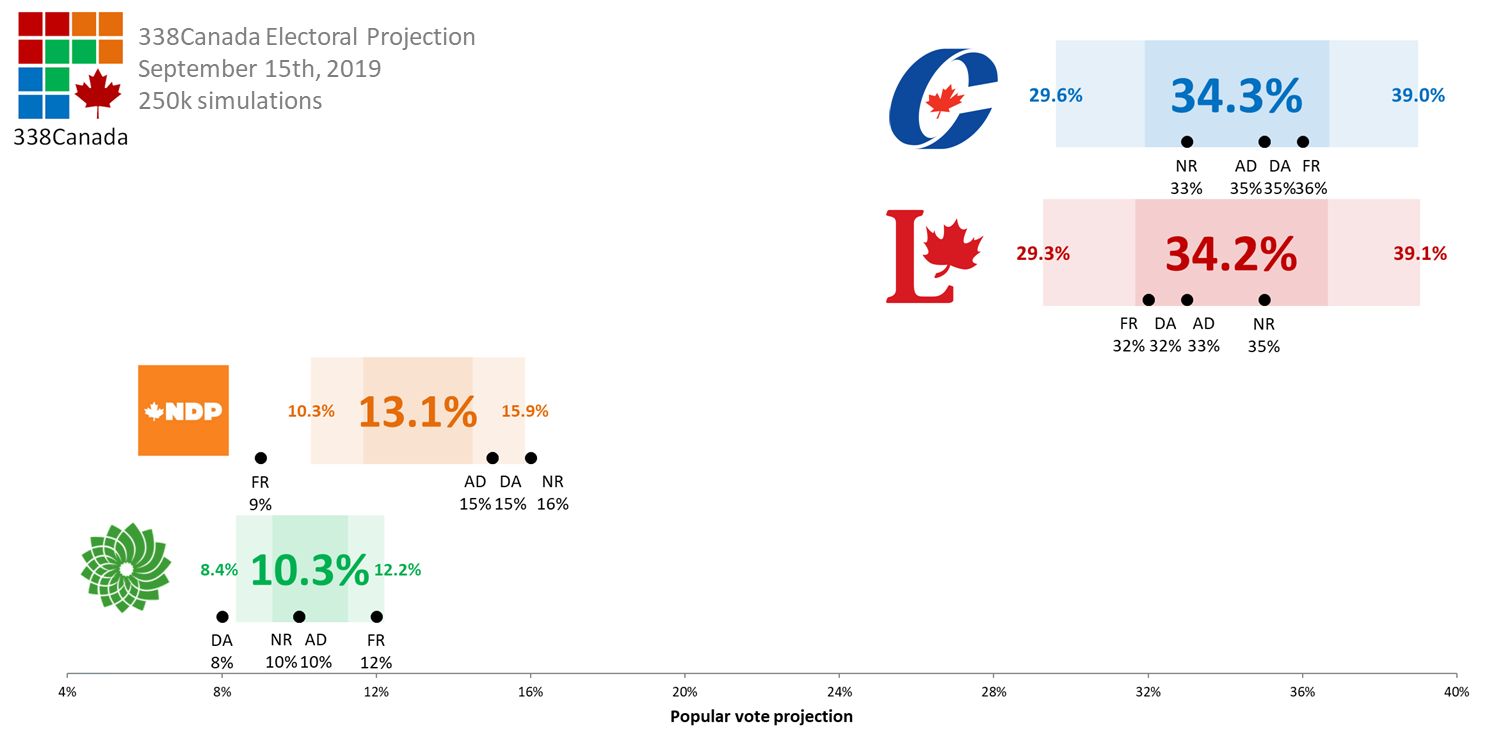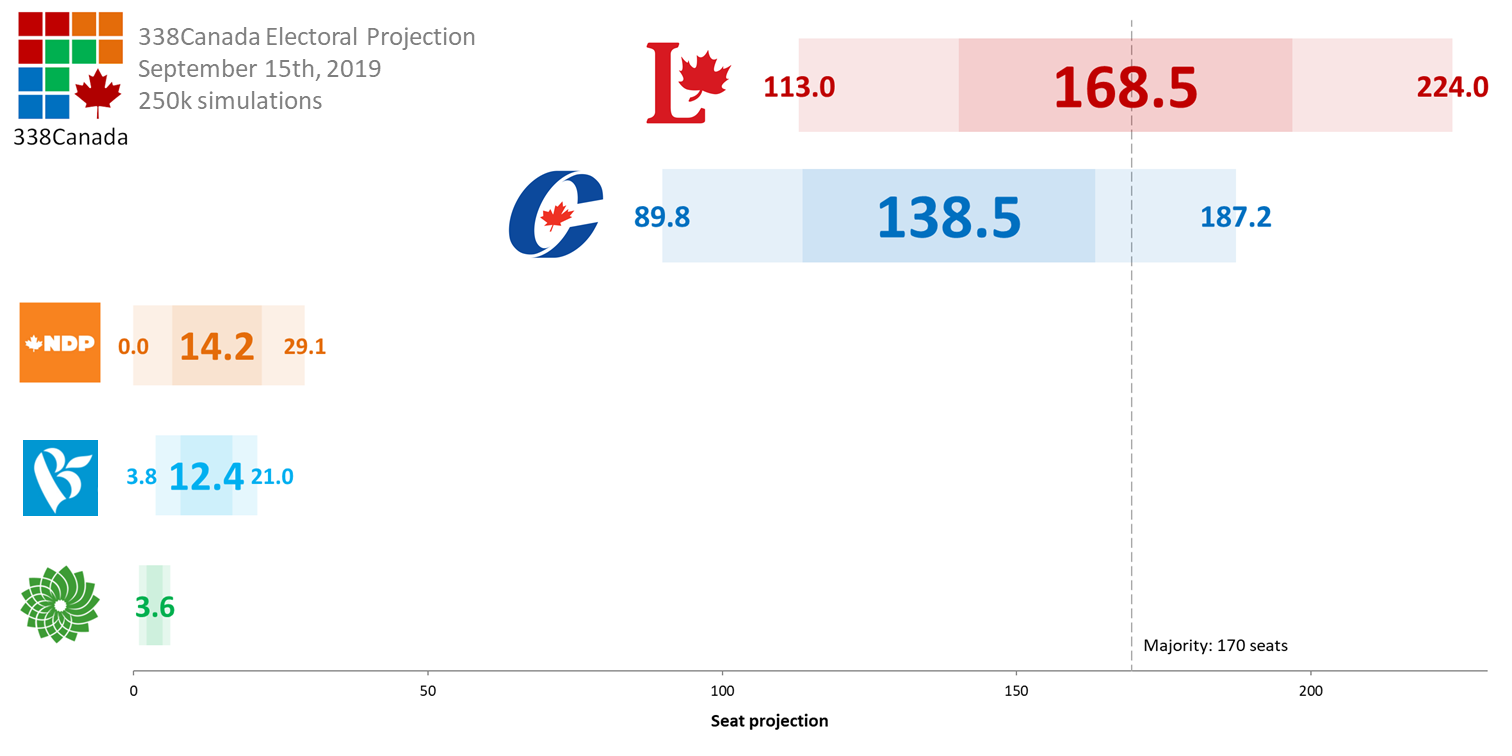This week’s 338Canada projection: A look at where the pollsters agree and disagree
Philippe J. Fournier: The poll average shows an incredibly close race at the top, but no consensus on where NDP support stands

Conservative Leader Andrew Scheer steps off a transit bus in Mississauga, Ont., on Sept. 13, 2019 (THE CANADIAN PRESS/Paul Chiasson)
Share
The 43rd general election campaign was launched on Wednesday and leaders have begun to tour the country hoping to convince Canadians to trust them with their vote. Canadians will elect its new Parliament on Oct. 21, five weeks from tomorrow. Already plenty of fresh data has been published about the state of the race, so let’s get right into it:
- On Saturday, Abacus Data published its latest federal numbers (Abacus was in the field from Sept. 6 to 10, so this poll predates the election call). Abacus measures once again a close race between the two main parties with the Conservatives at 35 per cent nationally, two points ahead of the Liberals at 33 per cent. The NDP is a distant third at 15 per cent and the Greens are stalled at the 10 per cent mark. Abacus tested its panel respondents for the likelihood to change their mind and measured a still highly volatile electorate: 42 per cent of respondents say they are very likely or somewhat likely to change their minds. The Conservatives still hold the most solid base of voters: only 33 per cent say they could still change their minds. See Abacus’ latest findings here.
- Forum Research went in the field and collected voting intentions of Canadians on Wednesday, as Justin Trudeau visited the Governor General and launched the 2019 campaign. Forum has the Conservatives at 36 per cent nationally, 4 points ahead of the Liberals at 32 per cent. We should note that Forum has the Liberals in front by 20 points in Quebec, more than any other firm. See Forum’s full report here.
- DART also went in the field on Wednesday, and found similar results to Forum, with Conservatives ahead by three points over the Liberals (35 to 32 per cent). DART measured the Conservatives at 39 per cent back in August, so this is a significant 4-point drop for the CPC (39 per cent was fairly high compared to the poll average then, so it may have been a mild outlier). Contrary to both Abacus and Forum which show a close race in Ontario, DART has the Liberals at 40 per cent in province, seven points ahead of the Conservatives. See DART’s poll report here.
- Nanos Research published the first wave of its daily tracker (behind a paywall, subscribe here). We will not release content that is behind a paywall, but the main numbers were published on Twitter by Nik Nanos. Nanos has the Liberals in front by 2.6 points.
Compared to earlier this summer, federal polls have tightened up in the past weeks on where Liberal and Conservative support currently stand.
Let’s compare polls from the past two weeks to the 338Canada poll average (taken on the middle field date for each poll). Here are the results for the LPC (x-axis) and CPC (y-axis):
Interestingly, all polls currently stand within a three-and-a-half-point radius of the average on the LPC-CPC chart. What does it all mean? If the results of these polls appear to be telling dramatically different stories, it is because the race is incredibly close at the top. If, say, the Conservatives were leading on average by 12 points, two polls that measured CPC+9 or CPC+15 would not especially stand out. But Mainstreet at LPC+3 and Forum at CPC+4? There is a world of difference between those outcomes.
Let’s graph the same chart, but with the NDP (x-axis) and Greens (y-axis):
We notice there is significant disagreement among Canadian pollsters on where the NDP stands: Forum and Mainstreet, both using IVR technology (Interactive Voice Response, or automated calls), are polling the NDP in single digits (so was EKOS in late August, in yet another IVR poll) and on the verge of total collapse.
Other firms such as Ipsos, DART and Abacus—all internet panels—have the NDP ranging from 15 to 18 per cent. Nanos (which conducts live telephone polls) has the NDP at 16 per cent—a mere three points below its 2015 results. (Here is Mainstreet President Quito Maggi on the divergence between IVR and panel polls.) We will keep a close eye on these numbers as we go deeper into the campaign, but it is still curious that top line numbers generally agree, and it is the NDP support that pollsters can’t seem to agree on right now.
Here is the 338Canada popular vote projection from a weighted average of the aforementioned polls (see complete list of polls here and details on methodology here):
Unsurprisingly, the Conservatives and Liberals are tied—as they have been for weeks now—at 34 per cent apiece. The NDP remains a distant third at 13 per cent. The Greens remain at 10 per cent.
The regional breakdown once again favours the Liberals in terms of seats. Here is the 338Canada national seat projection:
The Liberals lead with an average of 169 seats, 30 seats ahead of the Conservative average of 139. However, as was mentioned last week, the Liberals still lead in districts that are projected either leaning or toss ups, which explains in part why the confidence intervals remain so wide.
- In Atlantic Canada, the Liberals remain alone in first place. Even though the Liberals are down in the region compared to their 2015 results (when they swept all 32 districts), the LPC is still projected with a double-digit lead over the Conservatives.
- In Quebec, the non-Liberal vote is splintered among the Bloc and the Conservatives. The NDP’s collapse in the province therefore helps the Liberals, which are projected leading in close to 50 districts, even though the LPC’s vote share in Quebec is similar to its 2015 result.
- In Ontario, Liberals are averaging 39 per cent support—six points fewer than in 2015, while the Conservatives remain at 33 per cent on average. This gap between the main parties helps Justin Trudeau especially in the GTA, but since so many districts are so close as of this writing, just a 2-to-3-point swing could flip more than a dozen seats.
- In the Prairies, the Liberals are projected leading in many of their Winnipeg districts, but Conservatives should be able to make gains in the region if those numbers hold.
- In Alberta, where the Conservatives took 29 of 34 seats in 2015, a complete 34-seat Conservative sweep is not an unlikely scenario. It appears all four Alberta districts the Liberals won in 2015 could return to the Conservative fold, although local polling (expected soon) will surely help clarify the actual landscape.
- Finally, British Columbia is, along with Quebec, the province where voting intentions are most splintered. The Conservatives lead with an average of 34 per cent in the province and are projected ahead in most rural districts. The Liberals hold their own with 29 per cent, but this support is concentrated in the Vancouver area. The NDP stand at 19 per cent and the Greens, 15 per cent.
More polls are expected this week and we will know whether the first days of this campaign—which included the Maclean’s/Citytv leaders debate—have moved the needle at all.



